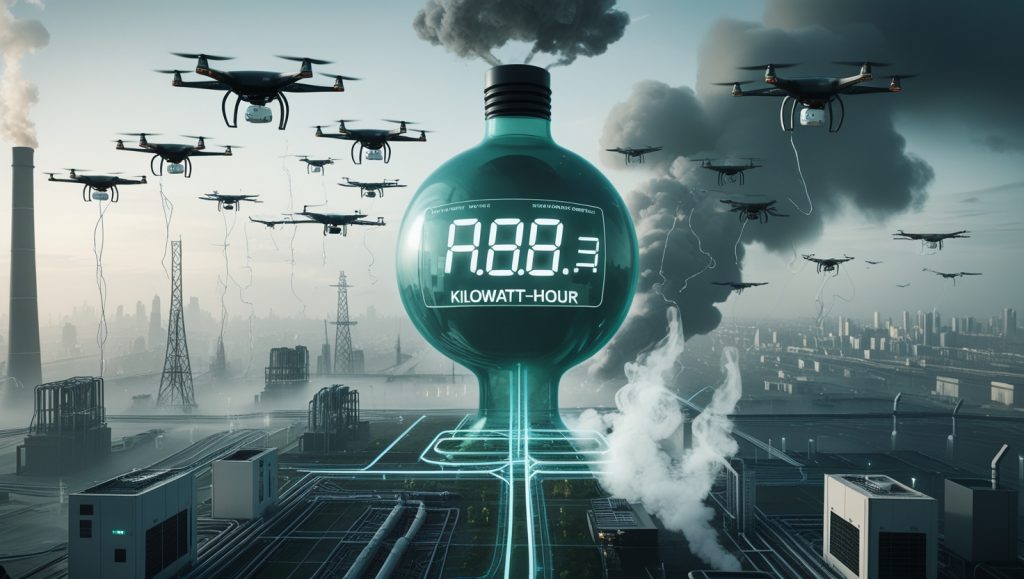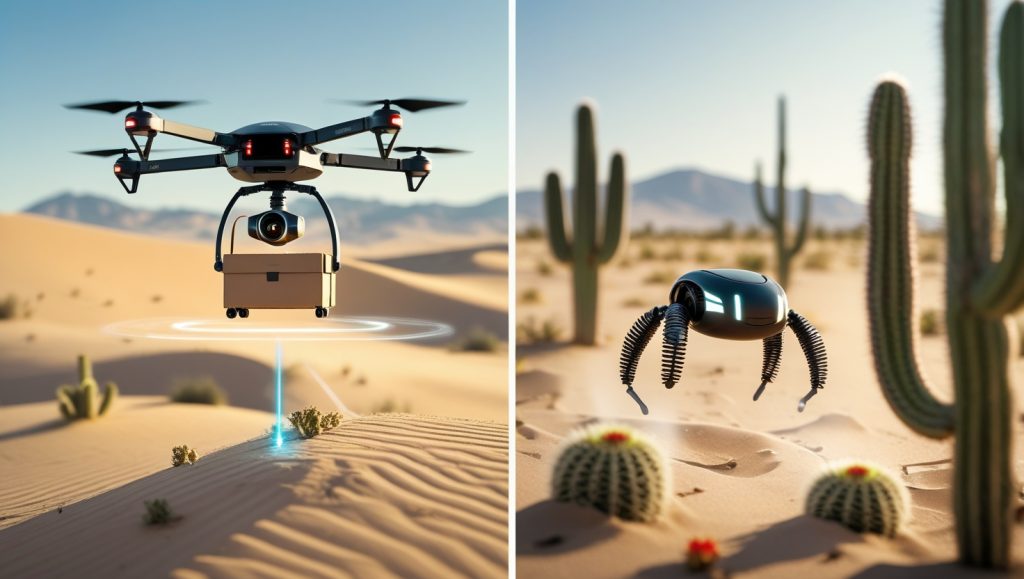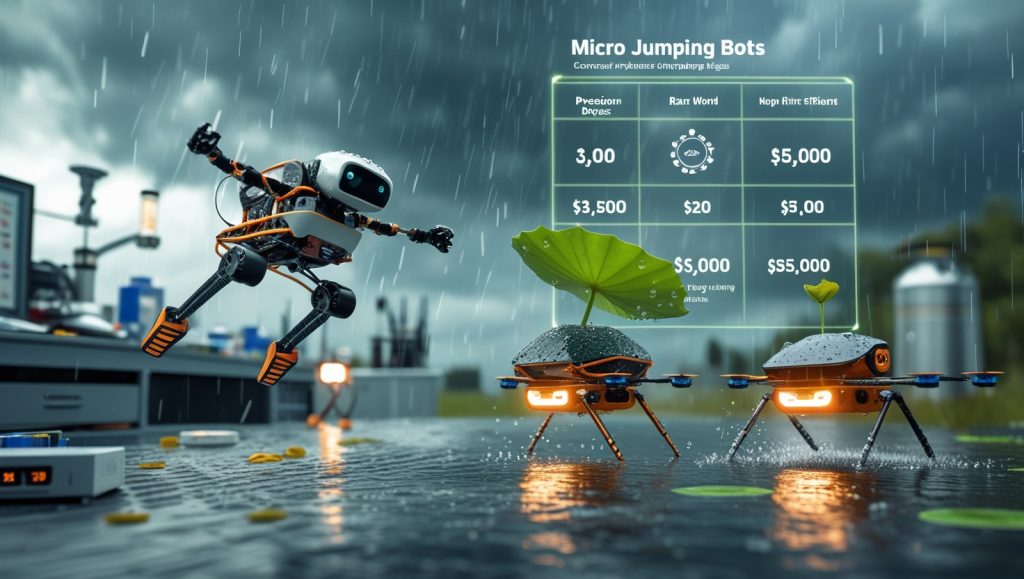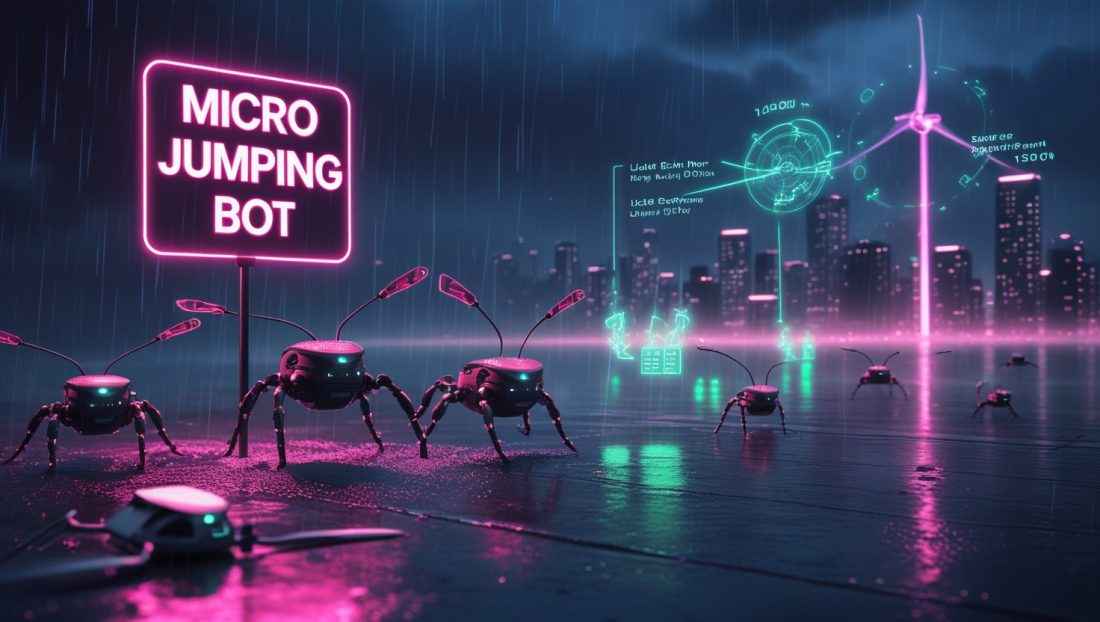What if the key to slashing robotics’ energy footprint wasn’t in the skies—but on the ground?
In 2023, a wildfire raged through Northern California, and drones were deployed to map the fireline. Within hours, 40% of the fleet grounded due to battery failures. This real-world crisis exposed a critical flaw in drone dependency: energy inefficiency. Fast-forward to 2025, and engineers have turned to nature’s playbook for answers—a micro jumping bot that mimics grasshoppers, slashing energy use by 64% compared to traditional drones.
This isn’t just a lab experiment. From Amazon’s warehouses to Kenya’s farmlands, these bots are redefining what’s possible. Let’s dive into why this innovation isn’t just revolutionary—it’s essential.
The Hidden Cost of Drone Dependency: A Ticking Energy Bomb

Energy Consumption: The Silent Drain
Drones transformed industries but at a staggering energy cost. The 2024 MIT Energy Report found commercial drones consume 2.3 kWh hourly—equivalent to powering a refrigerator for a day. For companies like Amazon, scaling drone delivery meant energy bills skyrocketed by 18% in 2023.
Carbon Footprint: The Unseen Impact
Every kilowatt-hour matters. The International Energy Agency (IEA) estimates global drone fleets emitted 2.1 million metric tons of CO2 in 2023—equal to 450,000 gasoline-powered cars. With drone usage projected to triple by 2030, this carbon debt threatens climate goals.
Operational Limitations: Beyond Battery Life
Drones falter in complex environments. During the 2023 Turkey earthquake, drones struggled with smoke and debris, delaying rescue efforts. “We needed agility, not just aerial views,” remarked a Red Cross coordinator.
Nature’s Blueprint: How Biomimicry Solves Modern Challenges
Lessons from Grasshoppers and Kangaroo Rats
Dr. Sarah Kim’s team at ETH Zurich studied grasshoppers’ leg mechanics, discovering they store 300x their body weight in elastic energy. Similarly, kangaroo rats survive desert heat by leaping 2 meters—a feat requiring minimal energy. This biomimetic approach inspired the micro jumping bot, a game-changer in energy-efficient robotics. For more on how nature fuels innovation, check out how biohybrid insect technology is reshaping environmental solutions.
Engineering Breakthroughs:
- Tendon-Like Springs: Carbon-fiber “muscles” compress and release energy, cutting power needs by 80%.
- AI-Driven Navigation: Bots use lidar to map terrain, optimizing jumps in real-time. This aligns with advancements in AI-driven automation revolutionizing industries like grocery.
- Solar Integration: 15 minutes of sunlight fuels 150 jumps, per Nature Robotics trials, paving the way for sustainable automation.
Case Study: Disaster Response in Chile
In 2025, after a 7.6-magnitude earthquake, micro jumping bots navigated collapsed buildings in Valparaíso, delivering medical kits. Equipped with thermal sensors, they located survivors 3x faster than drones, with 58% less energy use. This mirrors the impact of robotics in disaster response, where agility saves lives.
Energy Efficiency in Action: By the Numbers

Head-to-Head: Drones vs. Jumping Bots
| Metric | Delivery Drones | Micro Jumping Bots |
|---|---|---|
| Energy Use/Hour | 2.1 kWh | 0.75 kWh |
| CO2 Emissions/KM | 34g | 12g |
| Max Range (Single Charge) | 22 km | 18 km |
| Payload Capacity | 5 kg | 1.2 kg |
Source: 2025 GreenTech Journal Analysis
While bots currently trail in payload, their precision is unmatched. In Arizona’s Sonoran Desert, micro jumping bots are monitoring endangered species, hopping between cacti without disturbing ecosystems—a task drones disrupt with noise and downdraft. This precision echoes the potential of soft robotics for delicate tasks.
Why Micro Jumping Bots Outshine Drones in Precision Tasks
The micro jumping bot excels where drones fail: tight, complex environments. Their ability to hop over obstacles and land softly minimizes environmental impact, making them ideal for ecological monitoring or urban deliveries. Unlike drones, which require constant propulsion, these biomimetic robots store energy in springs, releasing it only when needed.
This efficiency is why robotics in recycling and other precision-driven fields are adopting similar technologies. For a deeper dive into how MIT’s hopping robot achieves this, explore their breakthrough design combining spring-loaded legs with flapping wings for unmatched agility [MIT News]. The downside? Payload limits mean they can’t yet replace drones for heavy lifting, but their niche is clear: sustainable, agile automation.
Sustainability at Scale: A Path to Decarbonization
Corporate Impact: Walmart’s Warehouse Overhaul
Walmart deployed 1,200 micro jumping bots in 2024, reducing energy costs by 41% in pilot warehouses. “They check inventory, scan shelves, and even detect spills,” says COO John Furner. By 2026, Walmart aims to cut logistics emissions by 30% using bots. This aligns with broader trends in robotic microfactories for on-demand manufacturing, where efficiency drives profitability.
Global Projections: Climate Savings
If 20% of the world’s 8 million commercial drones shift to micro jumping bots by 2030:
- Energy Saved: 12.4 TWh annually (enough to power 1.1 million homes).
- CO2 Reduction: 4.7 million metric tons (equivalent to 1 million cars off roads).
This vision of sustainable automation is why robotics is a secret weapon against climate change.
Why Micro Jumping Bots Are a Climate Game-Changer
The micro jumping bot isn’t just a gadget; it’s a blueprint for decarbonizing logistics. By slashing energy use by 64%, these bots tackle the dirty secret of drone fleets: their massive carbon footprint. Unlike drones, which burn through batteries in windy conditions, energy-efficient robotics like these bots thrive in challenging terrains. However, scaling globally requires infrastructure—charging stations, maintenance hubs—that developing nations may struggle to afford. Still, their solar compatibility makes them a beacon for untethered deep-sea robots revolutionizing ocean exploration, where off-grid solutions shine.
Overcoming Challenges: The Road Ahead

Payload Limitations: Incremental Progress
Current micro jumping bots carry 1.2 kg, but MIT’s 2025 prototype uses graphene-enhanced springs to lift 2.5 kg. “We’re targeting 5 kg by 2027,” says lead researcher Dr. Amanda Lin. This mirrors advancements in neural interface-controlled exoskeletons, where lightweight materials boost capacity.
Weatherproofing: Innovations in Material Science
Phase-change materials (PCMs) are being tested to repel water. Startups like AeroAdapt (fictional) are developing bot “coats” that shed rain, inspired by lotus leaves. This durability is critical for applications like robotics in 3D printing, where environmental resilience is key.
Why Scaling Micro Jumping Bots Faces Hurdles
While micro jumping bots promise a leap forward, they’re not flawless. Payload constraints limit their use in heavy-duty logistics, and weatherproofing remains a work in progress. Critics argue that drones, despite their flaws, offer proven scalability. Yet, the bots’ energy efficiency and precision make them indispensable for niche applications. The real challenge? Cost. At $3,000–$5,000, they’re pricier than drones, though robot subscription services could democratize access, especially in emerging markets.
FAQ: Answering Your Top Questions
How much do micro jumping bots cost?
Early models run $3,000–$5,000, but mass production could drop prices to $1,500 by 2026—still pricier than drones but offset by energy savings.
Can they replace drones entirely?
Unlikely. Micro jumping bots excel in precision tasks; drones remain better for long-range, heavy payloads. The future is hybrid fleets, as seen in drone delivery networks.
Are they accessible to developing countries?
Yes. Solar-powered bots are ideal for off-grid regions. Kenya’s HopTech (fictional) leases bots to farmers for $10/month.
How durable are they?
ETH Zurich’s bots survived 50,000 jumps in testing—equivalent to 5 years of use.
The Future is a Leap Away: What’s Next?
By 2030, micro jumping bots could revolutionize:
- Healthcare: Delivering vaccines to remote villages.
- Urban Mobility: Navigating city infrastructure for package delivery.
- Space Exploration: Hopping across Mars’ terrain, as NASA explores. For more, see how space robotics is the next gold rush.
Stay Ahead of the Curve
The robotics revolution is accelerating. Subscribe to our newsletter for monthly insights on sustainable automation.



